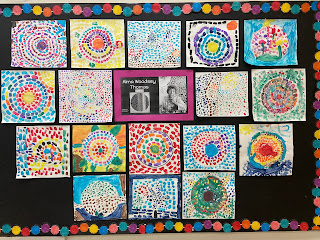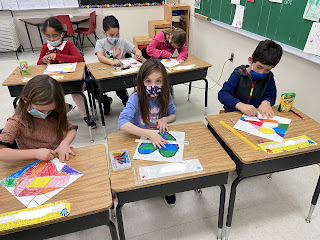Dear families,
Happy New Year, again! Our class was SO excited to make lanterns for Lunar New Year on Tuesday, and we learned a bit more about this important celebration through some videos, books, and a little research! I was feeling ambitious and tried a slightly more advanced lantern design, and they turned out great! The kids were so happy to bring them home right away! We learned that we are entering the year of the Tiger. I also looked up that 2015 was the year of the goat/sheep, so I think we are all goats (well, not me)! In celebration of this, I found some colouring pages featuring tigers, goats and lanterns. I've never had such an amazing class of artists, and honestly, these are adult colouring pages, and they LOVE it and do such a detailed job. Only a few artists let me keep their work for the wall... Mr. Lee taught our class a Korean song and dance. He sent me some short videos which I will try to link to Google Classroom for you!











February 1st also marked the start of African Heritage Month at the TDSB, so we were invited to view [part of] a live webcast that featured music, a story, and many speakers. We will have some more discussion and stories to celebrate this month in the coming weeks.
You may have heard that last week, we went on a virtual field trip to the ROM! We had a great French presenter who showed us many fossils and skeletons from the dinosaur exhibit. She explained three characteristics that all dinosaurs have. They must have legs that go straight down, scales on their body and they must lay eggs. We tried to decide whether the examples she showed were dinosaurs or not, based on these characteristics. We even learned that birds are descended from dinosaurs and share these characteristics! She joked that when we eat chicken, we can say we're eating dinosaur! We got to pose like some dino skeletons, and she even answered a question we put in the chat! It was a great presentation!



This Wednesday, we had another virtual field trip, again hosted by the ROM (and again, FREE for us). This presentation was called "Indigenous Perspectives" and took us to the First Peoples Gallery. We learned about canoes as an important mode of transportation for Indigenous groups, and how they were traditionally made of Birch bark. We watched an video of the bark being stripped from a tree and a canoe being made, using other resources like the tree roots as a sort of thread. I didn't realize that if only thin sheets of bark are removed, Birch and Cedar trees can go on living. We got to interract with our presenter through the chat, answer her questions, and after she taught us how to say goodbye in her language, we said au revoir, in French. Please ask about both of these exciting presentations!
Another component I have added to our weekly schedule is a bit of free choice time. I have come up with 6 centres with our new Lego, and the other building materials and games that we have. Students get to select what centre they go to, up to 4 people at any centre, so they may have to take their second choice sometimes. They will end up with an activity they like, and classmates who want to do the same thing. These short periods once a week will give us more opportunities to build friendships with our classmates, as there tends to not be a lot of unstructured time indoors, and outside it can be quite different and I am not always there to support. It's nice to see everyone enjoying themselves!
Wow, so much special stuff going on, and more fun to come this month! On to some reminders and subject updates.
Some reminders:
- Our library period is on day 4, this is currently Fridays - students can only sign out a book if they've returned the previous one.
- I usually give out words of the week on Tuesdays, but right now that's Mr. Lee's morning, so we will do it on Wednesdays until after Family day.
- Please check that your student has indoor shoes at school (and that they fit!)
Art
Last week we explored a different drawing tool: chalk. We learned a few techniques, such as smudging, and I put an inspirational demo video on in the background. Students tried one plain white winter scene, and then one colourful picture. They brought one chalk drawing home already, and the second is on display.
Science
We have continued to talk about the properties of different materials. Last week, we did another experiment to test whether various objects would sink or float. We first predicted which objects we thought would sink. Then, each student got to place one object in the bowl of water and we noted what happened on our experiment sheet. We learned that object that had air in them were more likely to float, even if they were heavier items. Ask what happened with the orange! This week we will be talking about structures that are natural v. man-made.
Math
We finished our recycled 3D structures, painted them and presented them. We had a lot of fun doing this, and of course, the kids couldn't wait to bring them home. I did use a rubric to mark these (mostly the labeling of 3D shapes) and will send that home soon for you to glance at. We are doing a bit more review of 2D and 3D shapes, and finishing up some symmetry activities we started at math centres last week, using a neat tool called a Mira. Using these reflect-mirrors, you can test if a shape is symmetrical, or look through it to see the lines for the other half of an image you want to be symmetrical. They are really fun to use!
French
Over the last month, I've been able to read a RAZ-kids book with every student, either online or at school. Now that we are at school, I'd like to have another meeting with each student to read a book they've never seen before, but that will take some time. We have started working on the sounding out strategy in reading and in writing. Each morning in the morning message, we continue to circle many vowel sounds that we know. Then, we work on adding just one letter, a consonant, ahead of the known sound. We can then look at each part of longer words and slowly combine them. Please try this in your at-home reading, if you aren't already.
Previously, in writing, we tried to sound out a poem that we know very well. I encouraged the writers to repeat the words slowly in their head, trying to listen for and write down every sound they heard. Even though the spelling may not be perfect, I can read each student's writing and understand what they were trying to write. It was a great first effort. These are currently on display, but have been marked using a rubric and I will send them home together soon so you can see how sounding out is going so far.
Currently, we are learning to write instructions. Last Friday, I asked students to review with a parent how to make a simple snack they can prepare on their own, for example a PB & J sandwich. I was thrilled that on Monday, everyone had an idea for the snack they can make (some really interesting ones too... a strawberry kitten? face on toast!). We are going to make a class recipe book!
It seems that everyone knows what they need and how to assemble their snack, and all I have to do is help with vocab, but do check in with your writer and make sure they know the steps they need to explain in their recipe.
Words of the last 2 Weeks
We've already been introduced to the sound ‘en’, which can also look like ‘em’. Well, there are two more ways to make this same sound: ‘an’ and ‘am’.
“Maman” was a bonus word in September, but now we have the tools to be able to catch that final syllable. Again, search for this sound (and others) before starting to read a book. See if it’s in a word you already know or that you can sound out. That way, when you get there, you’ll be able to read more fluidly.
maman, dans, enfant, grand, janvier
Bonus words: le camping, avant
This week we have the sound ‘ui’. We’re all familiar with this sound because of one of the first words we ever learned, “oui” (=yes). It sounds just like the word “we” in English.
It is common to see students write this sound with a 'w'. This is exactly how it sounds, and they’re using what they know. We’ll start correcting it in our writing now so that we get in the good habit of spelling it correctly. This week, our class came up with the bonus words all on their own! They were thinking of all kinds of words that rhyme!
oui, huit, puis, fruit, je suis
Bonus words: pluie, biscuit

3D shapes! "Madame! It's a cone!"



































































































